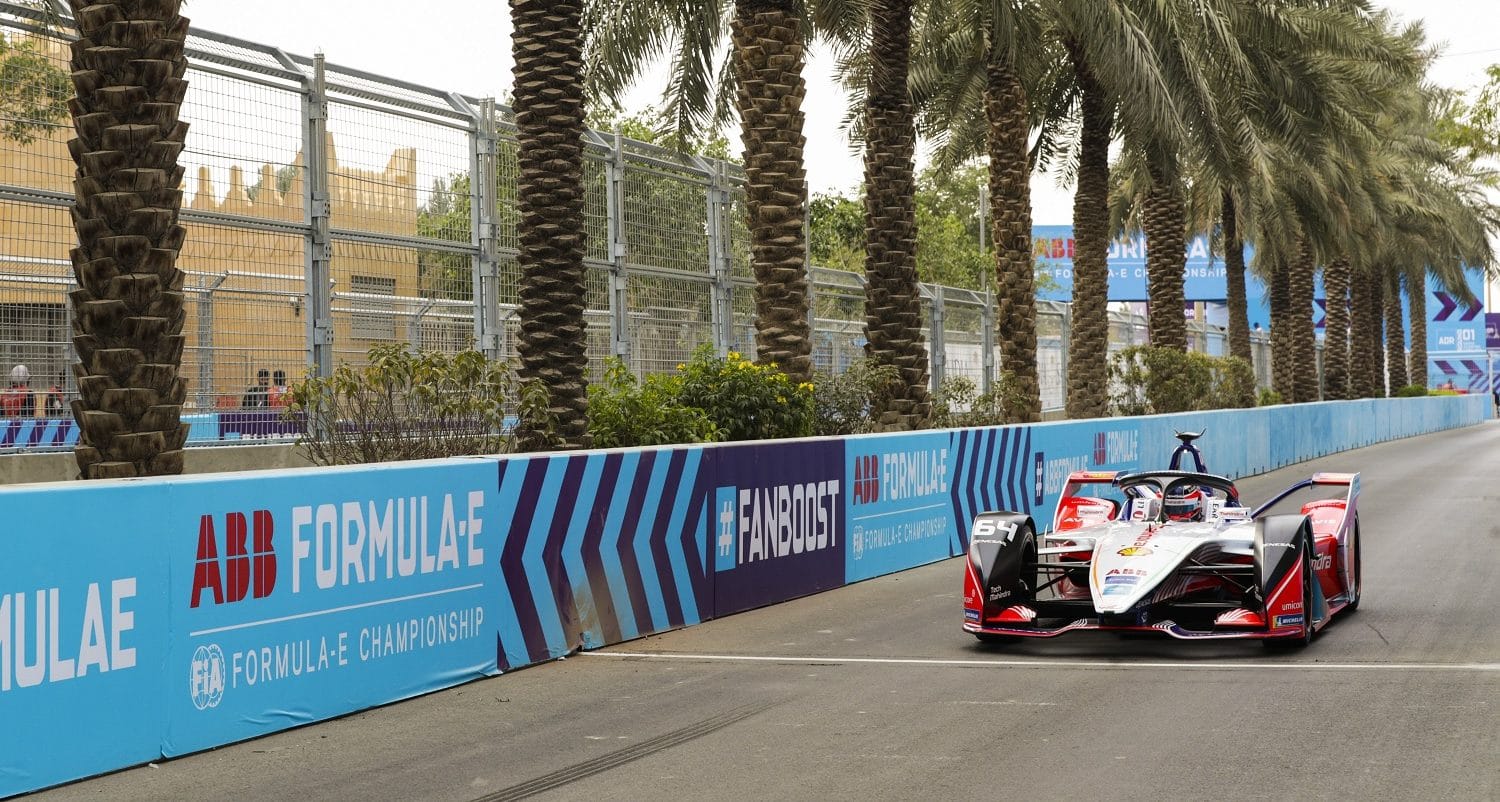
Preview: FE – New Teams, New Drivers, But is it Still the Same Great Racing?
The ABB Formula E Championship returns for its sixth season at the Ad-Diriyah Street Circuit for what might become the series traditional start point. As has also become tradition, Formula E has a variety of new regulations and most notably for this season, a twelfth team.
Porsche bring the number of power units up to 11, with Envision Virgin hanging on as the sole customer to Audi, while GEOX Dragon run a non-manufacture with the Penske EV-4. This means the number of drivers have increased to 24, with 2019 FIA F2 champion Nyck de Vries, former Toro Rosso driver and WEC champion Brendon Hartley and 2019 Le Mans class winner James Calado all making their debuts.
In recent years, Formula E has garnered a reputation for close racing and incredible action while remaining road relevant. Though as yet more changes are announced, how does Formula E balance the line between competitiveness and chaos.
It’s no secret that last years title battle was one of the the most open ever. It’s a statement that might seem comical when you consider that Jean-Eric Vergne would eventually win the title by 17 points, having been 32 ahead after the penultimate round. Though when you consider he was 26 points behind Sam Bird in Hong Kong (having gone on a three race no-points streak) it was a miracle he was even in the competition at all.
Winning proved to be catastrophic for many drivers chances; Da Costa’s double retirement after Saudi, d’Ambrosio failing to pick up a podium after Marrakesh, Frijns’ four race non-scoring run, to name a few. Even Vergne failed to score after his (at the time) fluke Sanya win. Further victories in Monaco and Bern would end the top step roulette as eight drivers from seven teams won the first eight races, as a usual championship battle between Vergne, Lucas di Grassi, Sebastian Buemi and Mitch Evans emerged in the latter rounds. Buemi’s turn around in form being most notable after his failure to score a top five until the middle round of the year at Rome, followed by a four race podium streak in the final four races, launching him from fourteenth to second in the standings.
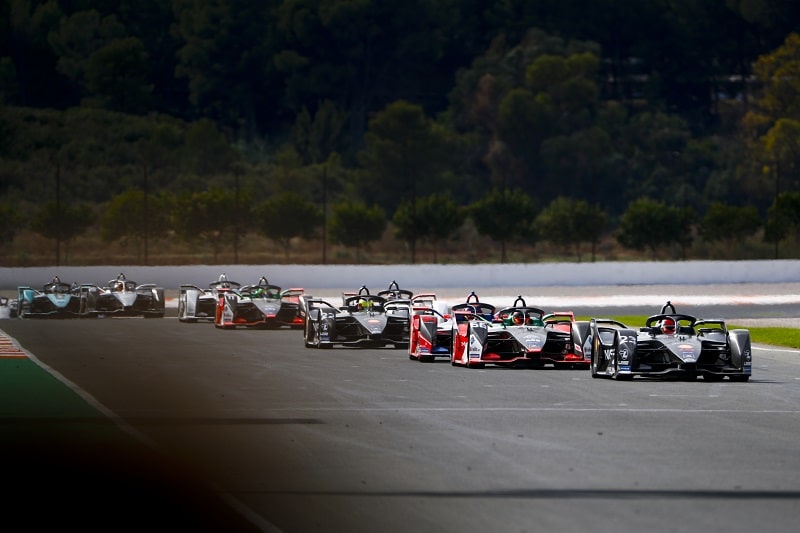
Who to watch out for in 2020?
Like they did last season, BMW topped the first day of pre-season testing with Maximillian Guenther leading the way in the morning session before Sam Bird went quicker in the afternoon. The benchmark time would drop over the three days, going to Robin Frijns and Pascal Wehrlein before BMW and Guenther reasserted their dominance on Friday with a 1min 15.087 around an edited Circuit Ricardo Tormo. Notably though, it was Stoffel Vandoorne who won the trial race on Wednesday for Mercedes EQ’s rebranded outfit.
Frijns had set the fastest lap during that Trial race and times throughout the week backed up that the BMW’s and Envision Virgin’s were outright the fastest cars. Guenther will likely be the underdog of the season; having spent a year in-and-out of an underperforming GEOX, he still managed to be a confident team leader and with quicker machinery has already proven himself faster than the experienced Alexander Sims, who admitted to Motorsport Radio earlier this year that he was happy to play the #2 role to Da Costa. Whether he’ll give the same respect to the German is yet to be seen.
Da Costa himself made the jump over the DS Techeetah alongside JEV for season six, a move that, for the first time, will not see him as the team leader. The double Macau GP winner has beaten his teammate in all-but-one of his five FE season, though up against the double champion will have his work cut out. Vergne will be expected to challenge for a third title and he’d be right to be cautious of Buemi and di Grassi after last season’s late scramble, but will hope to avoid dropping easy points in the early rounds this season.
What’s changed?
It seems as if we can’t go a second without something revolutionary being introduced to the premier electric racing series, though with innovation built-in and traidition regularly squandered, perhaps it’d be unusual to not see it. Perhaps the most notable change to the racing will be the removal of Attack Modes during FCY’s and safety cars.
This of course stops drivers from using up potential race penalties, as seen in Hong Kong amogst other ePrix’s, in return Attack mode power increases from 225 to 235kWh. This won’t be the only change under FCY/SC’s either, with 1kWh being removed per minute under caution. An unusual change that should have minimal impact, but could result in slower ends to the race, perhaps benefitting those who haven’t managed their energy properly.
Elsewhere, qualifying will now see more reward as 1 point is awarded to a driver for topping his qualifying group. Each group will have 6 drivers next season, but after the topsy-turvy quali results of Season 5 (in which championship leaders almost never started at the front) it could prove crucial to give drivers more to fight over early on Saturday. This also helps even out the qualifying reward diaspora in which the pole sitter got 4 points, while the rest got nothing.
Finally, after the confusion of Bern last season, the countdown clock will stop under race suspensions, while the usage of twin-motors will be banned. Most teams already used a single motor, but will likely require a change for the Nissan team whose qualifying advantage was regularly wiped out during the race.
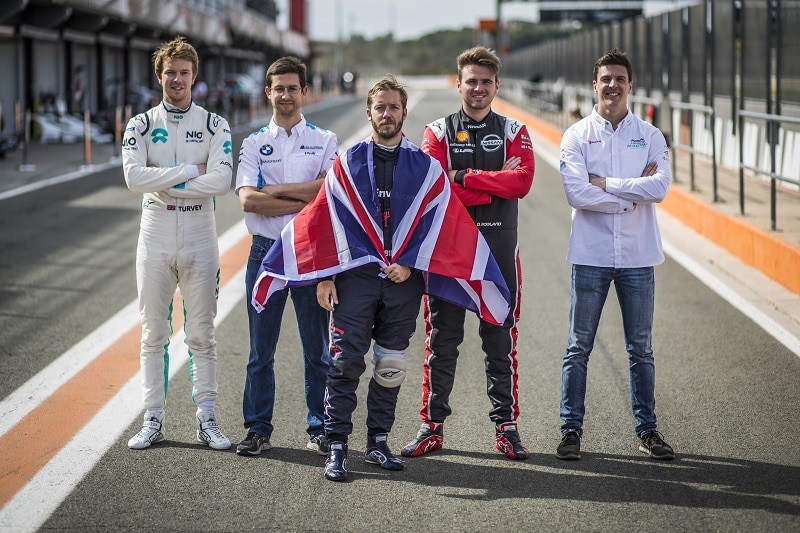
Calendar Crackdown
As with many parts of Formula E we’ve discussed today, the race schedule will again be changed. In a rare spark of consistency from the FIA, Ad-Diriyah begins the season, though this time a double-header will take place, similar to how we started Season 4.
Perhaps rather counterintuitively though, due to local Saudi laws about sport and leasure on Sunday, the races will instead take place on Friday and Saturday for the first time in the series history. While local customs and laws should always be followed, this move does raise questions over who FE was attempting to please, by making their season opener during a work day. Surely a disappointment for the sponsors and manufacturers who will likely see a reduction in TV viewership.
The Arabic connection is lost from last year with Marrakesh moving back to the end of February as Santiago and Mexico City make up the South American portion of the season. We then travel to the Far-East in March for Sanya, moving to Europe with Rome and Paris before moving back to the East for our debut’s in South Korea and Indonesia. Both are vital markets for the series and I feel the success of the Korean ePrix will come largely down to local manufacture involvement in the series. In the same way Korea lost F1 due to lack of long-term investment, a move by Hyundai, Kia, SsangYong etc will need to be expressed in the next twelve months as to not lose out to government-funded ventures such as Indonesia.
Travelling back to Europe for the traditional Tempelhof round, Formula E will, for the first time, only have a single round in New York before a third trip to Europe for the season-ending double header at the ExCel Arena in London. FE’s first partially indoors track will create a specticle at the end of July to round out the longest season ever.
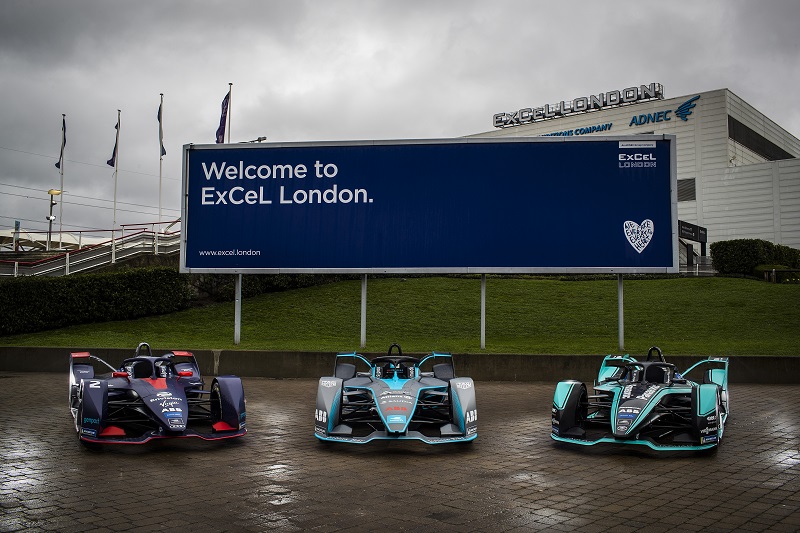
Travelling to 12 countries is perhaps expected for the series, but the geographically jumbled calendar could raise environmental concerns for the series with a green image. Two East Asian legs and three trips to European rounds seems unorganised. It’s not as if FE has been getting better either. If anthing, this season is the worst. Season 1 featured two Asian rounds, 2 South American and 2 North American before four back-to-back in Europe. In fairness to the series, gaps between rounds are longer than say F1 where moving venue-to-venue is the norm, but with France to Korea, Indonesia to Germany and USA to UK, just two weeks apart, and Mexico to Morocco one, it’s unlikely the majority of equipment will be shipped back to the factory, instead going straight to the venue.
Logistically, FE will need to look at its international travel in the future, either showing proof its electric technologies are being used to help reduce the carbon emissions per round, or publically accept its contridictions.
What to expect this weekend?
So as we approach the first round in Saudi Arabia what should we expect? Last year we had rain just before the race… in the desert… I know right.
The first round last year proved to us that testing can often be very wrong, though Da Costa did repeat his BMW’s dominance by taking pole by 0.3 seconds. He’d go on to win (his only of the season) before the Andretti cars dropped backwards as the season continued. Like last year, BMW enter the round as the pace setter and Guenther will be hungry to make an impact. The Virgin cars will also be ones to watch though neither scored points last year.
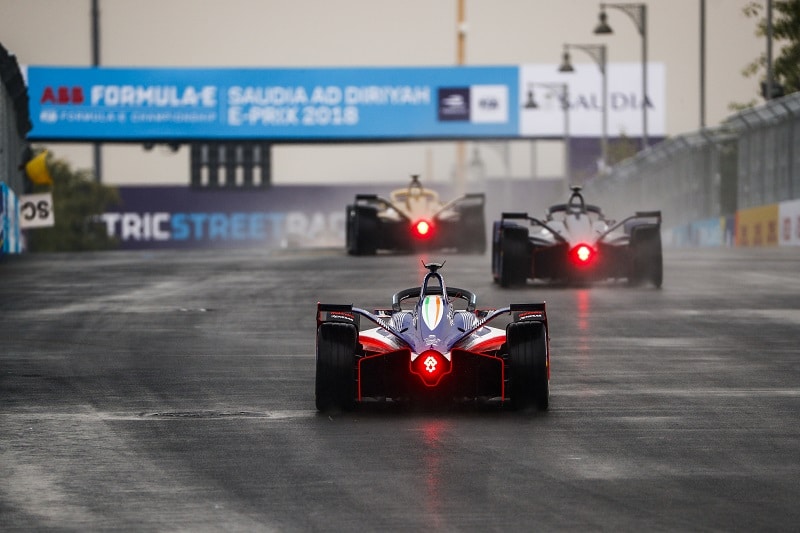
Mahindra will also be eager for a strong result as they, along with DS and BMW were the stars in the opening months of season five. Like last year though, Dilbagh Gill will know that consistency over a season will be vital to success. It will be a new round for Wehrlein who missed last season’s opener, but as one of only four teams to have retained their full line-up, they, along with Nissan, Audi and Virgin could yet prove to be threats for the points.
Without much on-track analysis, trying to compare which teams will peform best in Ad-Diriyah’s twisty 24-corner infield is difficult, especially when it might not matter as the only overtaking will occur on the long back straights.
Speaking after last years event, Maurice Hamilton of ESPN F1 described the circuit by saying; “[The] circuit that appeared to be weaving through a building site thanks to the impression of high screens blanking off construction work.” Whether this takes away from the actual racing we’ll have to see, but the first year did little to assuage concerns.
Formula E though, is nothing but unpredictable and we can only hope for more of the same in 2020.



![Private: [ID: 71rYi-xncgM] Youtube Automatic](https://motorradio-xijqc.projectbeta.co.uk/wp-content/uploads/2024/08/private-id-71ryi-xncgm-youtube-a-1-360x203.jpg)
![Private: [ID: 1SfHxvC8Doo] Youtube Automatic](https://motorradio-xijqc.projectbeta.co.uk/wp-content/uploads/2024/07/private-id-1sfhxvc8doo-youtube-a-1.jpg)
![Private: [ID: H6XRkf6kROQ] Youtube Automatic](https://motorradio-xijqc.projectbeta.co.uk/wp-content/uploads/2024/07/private-id-h6xrkf6kroq-youtube-a-1-360x203.jpg)
![Private: [ID: Kb6w-qAmKls] Youtube Automatic](https://motorradio-xijqc.projectbeta.co.uk/wp-content/uploads/2023/12/private-id-kb6w-qamkls-youtube-a-360x203.jpg)
![Private: [ID: CcpwYw20k3k] Youtube Automatic](https://motorradio-xijqc.projectbeta.co.uk/wp-content/uploads/2024/07/private-id-ccpwyw20k3k-youtube-a-360x203.jpg)

![[ID: x1SiRC5jhW4] Youtube Automatic](https://motorradio-xijqc.projectbeta.co.uk/wp-content/uploads/2022/04/id-x1sirc5jhw4-youtube-automatic-360x203.jpg)
![[ID: lMZ8lAeLubk] Youtube Automatic](https://motorradio-xijqc.projectbeta.co.uk/wp-content/uploads/2022/04/id-lmz8laelubk-youtube-automatic-360x203.jpg)
![[ID: GAYCcnqyFo4] Youtube Automatic](https://motorradio-xijqc.projectbeta.co.uk/wp-content/uploads/2022/04/id-gayccnqyfo4-youtube-automatic-360x203.jpg)
![[ID: Gg142H296QY] Youtube Automatic](https://motorradio-xijqc.projectbeta.co.uk/wp-content/uploads/2022/04/id-gg142h296qy-youtube-automatic-360x203.jpg)
![Private: [ID: 71rYi-xncgM] Youtube Automatic](https://motorradio-xijqc.projectbeta.co.uk/wp-content/uploads/2024/08/private-id-71ryi-xncgm-youtube-a-1-236x133.jpg)
![Private: [ID: H6XRkf6kROQ] Youtube Automatic](https://motorradio-xijqc.projectbeta.co.uk/wp-content/uploads/2024/07/private-id-h6xrkf6kroq-youtube-a-1-236x133.jpg)
![Private: [ID: Kb6w-qAmKls] Youtube Automatic](https://motorradio-xijqc.projectbeta.co.uk/wp-content/uploads/2023/12/private-id-kb6w-qamkls-youtube-a-236x133.jpg)
![Private: [ID: nc-8g6ROCe8] Youtube Automatic](https://motorradio-xijqc.projectbeta.co.uk/wp-content/uploads/2023/11/private-id-nc-8g6roce8-youtube-a-236x133.jpg)
![Private: [ID: wWrhfjOQuIc] Youtube Automatic](https://motorradio-xijqc.projectbeta.co.uk/wp-content/uploads/2023/11/private-id-wwrhfjoquic-youtube-a-236x133.jpg)